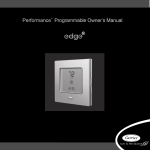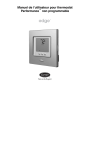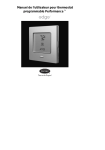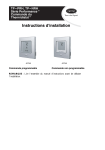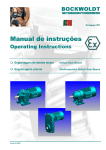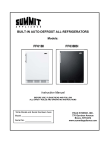Download Miller Electric MPS-10T Specifications
Transcript
OM-262 902A ® 2013−04 CoolBandtII Integrated Headgear Cooling System To help us serve you better, go to MillerWelds.com/CoolerNow TABLE OF CONTENTS SECTION 1 − HELMET COOLER SAFETY PRECAUTIONS − READ BEFORE USING . . . 1 1-1. Symbol Usage . . . . . . . . . . . . . . . . . . . . . . . . . 1 1-2. Hazards . . . . . . . . . . . . . . . . . . . . . . . . . . . . . . 2 1-3. Proposition 65 Warnings . . . . . . . . . . . . . . . . 4 1-4. Principal Safety Standards . . . . . . . . . . . . . . . 4 SECTION 2 − BATTERY SAFETY PRECAUTIONS − READ BEFORE USING . . . . . . . . . . . . . . . . . . 5 2-1. Symbol Usage . . . . . . . . . . . . . . . . . . . . . . . . . 5 2-2. Hazards . . . . . . . . . . . . . . . . . . . . . . . . . . . . . . 6 2-3. Proposition 65 Warnings . . . . . . . . . . . . . . . . 8 2-4. Principal Safety Standards . . . . . . . . . . . . . . . 8 SECTION 3 − HEADGEAR COOLING SYSTEM . . . . . . . . . . . . . . . . . . . . . . . . . . . . . . . . . . . . 3-1. 9 Headgear Cooling System Specifications . . 11 3-2. Installing Headgear . . . . . . . . . . . . . . . . . . . . . 13 3-3. Installing Head Shroud . . . . . . . . . . . . . . . . . . 14 3-4. Charging The Battery . . . . . . . . . . . . . . . . . . . 16 3-5. Installing The Battery . . . . . . . . . . . . . . . . . . . 18 3-6. Installing The Filter . . . . . . . . . . . . . . . . . . . . . 19 3-7. Removing Air Deflector To Adjust Air Flow . . 20 3-8. Operating The Controls . . . . . . . . . . . . . . . . . 22 3-9. Checking Headgear Cooling System Before Use . . . . . . . . . . . . . . . . . . . . . . . . . . . . . . . . . . 24 SECTION 4 − MAINTENANCE . . . . . . . . . . . . . 26 4-1. Adjusting Headgear . . . . . . . . . . . . . . . . . . . . . 26 4-2. Replacing Fabric Headband . . . . . . . . . . . . . . 28 4-3. Maintenance And Storage . . . . . . . . . . . . . . . 29 4-4. Headgear Cooling System Troubleshooting . 30 SECTION 5 − PARTS LIST . . . . . . . . . . . . . . . . 32 SECTION 1 − HELMET COOLER SAFETY PRECAUTIONS − READ BEFORE USING Protect yourself and others from injury — read, follow, and save these important safety precautions and operating instructions. 1-1. Symbol Usage Helmet Cooler 2011−10 DANGER! − Indicates a hazardous situation which, if not avoided, will result in death or serious injury. The possible hazards are shown in the adjoining symbols or explained in the text. Indicates a hazardous situation which, if not avoided, could result in death or serious injury. The possible hazards are shown in the adjoining symbols or explained in the text. . Indicates special instructions. This group of symbols means Warning! Watch Out! ELECTRIC SHOCK, MOVING PARTS, and HOT PARTS hazards. Consult symbols and related instructions below for necessary actions to avoid the hazards. NOTICE − Indicates statements not related to personal injury. OM-262 902 Page 1 1-2. Hazards Only qualified persons should install, operate, maintain, and repair this unit. READ INSTRUCTIONS. D D D Read and follow all labels and the Owner’s Manual carefully before installing, operating, or servicing unit. Read the safety information at the beginning of the manual and in each section. Use only genuine replacement parts from the manufacturer. Perform maintenance and service according to the Owner’s Manuals, industry standards, and national, state, and local codes. HELMET COOLER MISUSE can be hazardous. Welding produces fumes and gases. Breathing these fumes and gases can be hazardous to your health. D Read and follow these instructions and the safety labels carefully. This product is intended for use as a cooling device only. It is not a respiratory protective device and does not protect the user from airborne contaminants. Have an industrial hygienist test the air in your facility to determine if respiratory protection is required to provide adequate protection from contaminants in your environment. With cooling system-equipped helmet on your head and cooling system operating, also test the air inside the helmet to determine if respiratory protection is required. If you have questions about the type of respiratory protection equipment required, consult your safety director and a certified Industrial Hygienist. OM-262 902 Page 2 D D D D D D D D D D D Do not use this product where there is danger of fire or explosion. Do not use this product in windy conditions or negative pressure inside the hood may draw in contaminants from the outside air. Do not use this product without a properly installed spark guard unless the unit is designed and intended to be used without one. Without the spark guard (on applicable products), welding sparks may ignite the filter or damage the filter. This product does not supply oxygen. Do not use this product where oxygen levels are 19.5% or lower, where contaminant levels are unknown or are immediately dangerous to life or health (IDLH), or where the contaminant levels exceed the equipment specifications. Do not enter a work area until you are sure the equipment is correctly assembled, working properly, and properly worn. Before each use, inspect the equipment for damage and verify it operates properly. Dangerous contaminants may not smell or be visible. Leave the area immediately if you notice the following: . . . . Breathing becomes difficult. . . . . You experience dizziness, impaired vision, or eye, nose, or mouth irritation. . . . . The equipment is damaged. Do not repair, modify, or disassemble this product or use with parts or accessories not supplied by the manufacturer. Do not operate unit without properly installed filter(s). Replace damaged or clogged filters. Do not wash or reuse filters. Do not clean filters by tapping or with compressed air or filter elements may be damaged. Do not restrict or alter helmet cooler air flow. Do not block air inlet or outlet. Be sure safety glasses, hair, weld cap, and other objects do not block air flow. This product contains electrical parts which have not been evaluated as an ignition source in flammable or explosive atmospheres by MSHA/NIOSH. OM-262 902 Page 3 1-3. Proposition 65 Warnings Welding or cutting equipment produces fumes or gases which contain chemicals known to the State of California to cause birth defects and, in some cases, cancer. (California Health & Safety Code Section 25249.5 et seq.) This product contains chemicals, including lead, known to the state of California to cause cancer, birth defects, or other reproductive harm. Wash hands after use. 1-4. Principal Safety Standards Safety in Welding, Cutting, and Allied Processes, ANSI Standard Z49.1, is available as a free download from the American Welding Society at http://www.aws.org or purchased from Global Engineering Documents (phone: 1-877-413-5184, website: www.global.ihs.com). Safe Practice For Occupational And Educational Eye And Face Protection, ANSI Standard Z87.1, from American National Standards Institute, 25 West 43rd Street, New York, NY 10036 (phone: 212-642-4900, website: www.ansi.org). OM-262 902 Page 4 SECTION 2 − BATTERY SAFETY PRECAUTIONS − READ BEFORE USING Protect yourself and others from injury — read, follow, and save these important safety precautions and operating instructions. 2-1. Symbol Usage Small Batt 2011−10 DANGER! − Indicates a hazardous situation which, if not avoided, will result in death or serious injury. The possible hazards are shown in the adjoining symbols or explained in the text. Indicates a hazardous situation which, if not avoided, could result in death or serious injury. The possible hazards are shown in the adjoining symbols or explained in the text. . Indicates special instructions. This group of symbols means Warning! Watch Out! ELECTRIC SHOCK, MOVING PARTS, and HOT PARTS hazards. Consult symbols and related instructions below for necessary actions to avoid the hazards. NOTICE − Indicates statements not related to personal injury. OM-262 902 Page 5 2-2. Hazards Only qualified persons should install, operate, maintain, and repair this unit. BATTERY ACID can BURN SKIN and EYES. D D D Replace damaged battery. Do not touch materials from inside a damaged battery. Flush eyes and skin immediately with water. READ INSTRUCTIONS. D Read and follow all labels and the Owner’s Manual carefully before before using the battery or battery charger. Read the safety information at the beginning of the manual and in each section. D Dispose of battery according to local, state, and federal requirements. Do not dispose of battery in fire or water. D Contact the equipment manufacturer if you have any questions about the battery. OM-260 902 Page 6 FIRE OR BATTERY EXPLOSION hazard. D D D D D D D D D D D D D D During operation keep everyone, especially children, away. Do not install or place charger on, over, or near combustible surfaces. Do not charge battery near flammables. Examine the battery before first use. Return battery to the manufacturer if battery is damaged, dirty, or emits an unusual odor. Use battery only with equipment with which it was supplied. Replace battery only with battery specified in Owner’s Manual. Use of another battery may present a risk of fire or explosion. Keep battery dry. Do not use or store the battery in extremely hot or humid conditions. See the Owner’s Manual for specific operating and storage information. Keep battery away from fire, out of direct sunlight, and away from other sources of heat. Do not use or charge the battery if it has been dropped or damaged. Do not open, puncture, repair, disassemble, or modify the battery. Charge battery only with supplied charger in an open, well−ventilated location out of direct sunlight and according to supplied instructions. Do not overcharge a battery or charge battery longer than specified (if charger is not equipped with automatic shutoff). See the Owner’s Manual for specific information on battery charging. Do not charge battery by connecting directly to AC receptacle. Do not connect battery charger to automobile auxiliary power receptacle. Do not connect (short circuit) battery terminals to each other. Do not allow tools, conductive materials, or other objects to touch both battery terminals at the same time. OM-262 902 Page 7 2-3. Proposition 65 Warnings Welding or cutting equipment produces fumes or gases which contain chemicals known to the State of California to cause birth defects and, in some cases, cancer. (California Health & Safety Code Section 25249.5 et seq.) This product contains chemicals, including lead, known to the state of California to cause cancer, birth defects, or other reproductive harm. Wash hands after use. 2-4. Principal Safety Standards Safety in Welding, Cutting, and Allied Processes, ANSI Standard Z49.1, is available as a free download from the American Welding Society at http://www.aws.org or purchased from Global Engineering Documents (phone: 1-877-413-5184, website: www.global.ihs.com). Safe Practice For Occupational And Educational Eye And Face Protection, ANSI Standard Z87.1, from American National Standards Institute, 25 West 43rd Street, New York, NY 10036 (phone: 212-642-4900, website: www.ansi.org). OM-260 902 Page 8 SECTION 3 − HEADGEAR COOLING SYSTEM Read and follow these instructions and the safety labels carefully. This product is intended for use as a cooling device only. It is not a respiratory protective device and does not protect the user from airborne contaminants. Have an industrial hygienist test the air in your facility to determine if respiratory protection is required to provide adequate protection from contaminants in your environment. With cooling system-equipped helmet on your head and cooling system operating, also test the air inside the helmet to determine if respiratory protection is required. If you have questions about the type of respiratory protection equipment required, consult your safety director and an Industrial Hygienist. . Use the cooling system only with compatible Miller welding helmets (MP-10t, Pro-Hobbyt, Performancet, Elitet, Titaniumt series helmets). See the welding helmet Owner’s Manual for information on helmet operation. The CoolBandt headgear cooling system draws in air and blows it to the front of the welding helmet through a flexible tube. The system also generates a positive air pressure to help prevent contaminants from entering the helmet. The system must include and/or be used with the equipment listed below: D D D Helmet and cowl (head shroud) Blower assembly with properly-installed filter Battery charger The headgear cooling system operates at temperatures from 14° to 131° F (−10° to 55° C) The Battery Level red light flashes and blower assembly pulses on and off when battery power is low. OM-262 902 Page 9 . To better show components and features, the headgear cooling system is shown without welding helmet. OM-262 902 Page 10 3-1. Headgear Cooling System Specifications Application Fits Most Miller Welding Helmets Weight Approx. Total Weight With Battery: 455 Grams Approx. Added Weight To Helmet: 330 Grams Air Filter Use Miller Filter Only (Miller Part No. 243 932) . Filter is required for proper operation of equipment, but does not provide respiratory protection. NOTICE −Operating cooling system without a filter will damage fan motor and void warranty. Operating Temperature 14° to 131° F (−10° to 55° C) Storage Temperature (For Up To Six Months Storage With Battery 50% Charged) Acceptable: 23° to 95° F (−5° to 35° C) Preferred: 68° to 86° F (20° to 30° C) Battery Type Rechargeable Lithium, 1600 mAh, 7.4 V (Rated) 8.4 V (Fully Charged) (Miller Part No. 243 927) Battery Charging Time About 3.5 hours (Typical); 4.5 hours (max.) Battery Charging Temperature 32° to 104° F (0° to 40° C) OM-262 902 Page 11 Battery Life New Battery: 6 Hours Run Time (Typical); 5.3 hours (Min.) . Battery retains about 80% of original battery life after 300 charges. Battery may be recharged about 500 times. Cowl (Head Shroud) Service Life Replace After 50 Washings Battery Charger Input: 100-240 VAC 4.5W 50/60 Hz Output: 5.5-8.6 VDC 500mA (charging)−0mA(full) Compliant to FCC Part 15 Class B OM-262 902 Page 12 3-2. Installing Headgear 3 2 1 Tilt Resistance Knob 2 O−Ring 3 Washer Remove knobs, o− rings, and washers from helmet headgear. Remove helmet headgear. Install cooling system headgear and secure with knobs, o−rings, and washers. 1 Retain old headgear for future use. . See Section 4 for helmet adjustment information. OM-262 902 Page 13 3-3. Installing Cowl (Head Shroud) . 3 1 After installing shroud, make sure there are no gaps between shroud and helmet edge. 1 Cowl (Head Shroud) 2 Knob 3 Shroud Slots Slide slots on right and left side of shroud over knobs. Stretch shroud over helmet. . Shroud must be used when cooling system is on. Remove shroud from helmet when using helmet with the cooling system turned off. 2 OM-262 902 Page 14 Notes OM-262 902 Page 15 3-4. Charging The Battery 3 2 1 4 OM-262 902 Page 16 3-4. . . . Charging The Battery (Continued) Charge battery only with supplied charger in an open, well− ventilated location. Do not allow battery to get wet. Do not attempt to open the battery case. Keep battery away from fire or heat. . Charge battery before first use or if battery has not been used for five days. . Dispose of battery at a desig- nated collection facility. Place battery in charger. automatically stops when battery is fully charged. NOTICE − Do not press on battery with excessive force when battery is in charger. . Battery charging . Remove tape from battery terminals before charging battery. 1 Battery 2 Battery Charger 3 120 Volt 15 A AC Receptacle Remove battery from blower assembly (see Section 3-5). Extend prongs on back of charger and plug charger into AC receptacle. 4 Battery LEDs Charge LED(s) light to indicate approximate battery charge [1 LED = approx. 25%, 2 LEDs= approx. 50%, 3 LEDs= approx. 75%, 4 LEDs = approx 90% (continue 0.5-1 hr to 100% charge)] Charging normally takes between 3.5 hours (typical) and 4.5 hours (max.) OM-262 902 Page 17 3-5. Installing The Battery 2 1 . . Do not allow battery to get wet. Do not attempt to open the battery case. Keep battery away from fire or heat. OM-262 902 Page 18 . To 1 2 better show components and features, the headgear cooling system is shown without welding helmet. Access Door Battery Open battery access door. Slide battery into blower assembly until terminals touch back of battery compartment. . Install battery with terminals facing headgear cooling system as shown. Close door. 3-6. Installing The Filter . Do not use the headgear cooling system without the filter installed. . Replace damaged or dirty filter. Do not wash filter, clean with compressed air, or reuse dirty filter. NOTICE − Operating cooling system without a filter will damage fan motor and void warranty. . Filter is required for proper operation of equipment, but does not provide respiratory protection. 2 1 3 1 Filter Cover 2 Filter 3 Finger Tab Grip finger tab to pull cover away from blower assembly. Install filter. Reinstall cover so it fits tightly around filter area. . Filter is shaped to fit only one way in blower assembly. Be sure filter is installed correctly. OM-262 902 Page 19 3-7. Removing Air Deflector To Adjust Air Flow 1 2 D D Air Deflector Manifold With air deflector installed, air is directed to upper part of face. Remove deflector to direct air to lower part of face. Save air deflector for later use. 2 1 OM-262 902 Page 20 Notes OM-262 902 Page 21 3-8. Operating The Controls 1 2 . Read and follow these instructions and the safety labels carefully. This product is intended for use as a cooling device only. It is not a respiratory protective device and does not protect the user from airborne contaminants. Have an industrial hygienist test the air in your facility to determine if respiratory protection is required to provide adequate protection from contaminants in your environment. With cooling system-equipped helmet on your head and cooling system operating, also test the air inside the helmet to determine if respiratory protection is required. If you have questions about the type of respiratory protection equipment required, consult your safety director and an Industrial Hygienist. OM-262 902 Page 22 3-8. . 1 Operating The Controls (Continued) Do not restrict or alter headgear cooling system air flow. Do not block air holes (including upper and lower holes). Be sure safety glasses, hair, weld cap, and other objects do not block air flow. Power Button To Start: Press Power button. Blower assembly starts when button is released. long as battery charge is above 25 percent. To Stop: Press Power button again. When battery charge falls below 25 percent, light flashes red once per second. . Use light pressure on Power button to turn unit off. 2 Battery Level Light When powered up, light turns on green for two seconds and then flashes once per second as When the battery charge is depleted, the fan stops running and the red light flashes constantly. See Section 3-4 for battery charging information. OM-262 902 Page 23 3-9. Checking Headgear Cooling System Before Use . 4 3 2 1 OM-262 902 Page 24 Read and follow these instructions and the safety labels carefully. This product is intended for use as a cooling device only. It is not a respiratory protective device and does not protect the user 3 from airborne contaminants. Have an industrial hygienist test the air in your facility to determine if respiratory protection is required to provide adequate protection from contaminants in your environment. With cooling system-equipped helmet on 5 your head and cooling system operating, also test the air inside the helmet to determine if respiratory protection is required. If you have questions about the type of respiratory protection equipment required, consult your safety director and an Industrial Hygienist. 3-9. Checking Headgear Cooling System Before Use (Continued) . Do not restrict or alter headgear cooling system air flow. Do not block air holes (including upper and lower holes). Be sure safety glasses, hair, weld cap, and other objects do not block air flow. Before using the headgear cooling system, check the following items: 1 Filter . Filter is required for proper operation of equipment, but does not provide respiratory protection. NOTICE −Operating cooling system without a filter will damage fan motor and void warranty. Verify the filter is undamaged, properly assembled, and securely connected to the blower assembly. 2 Flexible Tube Be sure the tube is undamaged and properly connected to the manifold and blower assembly. 3 Battery Verify the battery is fully charged and secured in the battery compartment. 4 Power Switch Turn on blower assembly and test air flow. 5 To adjust direction of air flow, remove air deflector (see Section 3-7). 6 Shroud (Not Shown) Inspect the shroud and replace if damaged. See Troubleshooting (Section 4-4) if air is not being supplied to front of helmet. Put on helmet and adjust headgear so helmet fits snugly on head. Verify shroud is properly installed on helmet. . See Section 4 (Miller helmet) or the welding helmet Owner’s Manual for helmet adjustment information. Air Deflector OM-262 902 Page 25 SECTION 4 − MAINTENANCE 4-1. Adjusting Headgear 1 3 5 4 2 OM-262 902 Page 26 4-1. Adjusting The Headgear (Continued) . There are five headgear adjustments: headgear top, tightness, angle adjustment, distance adjustment, and tilt/resistance. 1 Headgear Top Adjustment Straps Adjust both headgear straps for proper depth on the head to ensure correct balance and stability. 2 Headgear Tightness To adjust, turn left or right to desired tightness. 3 Distance Adjustment Adjusts the distance between the face and the lens. To adjust, press tabs and slide forward or back to desired position. Release tabs (Both sides must be equally positioned for proper vision.) 4 Tilt Adjustment Is located on the right side of head gear, and is used to adjust forward tilt of the helmet. To adjust, press tab and slide clockwise to position lens closer to face. Slide tab counterclockwise to position lens further from the face. 5 Tilt/Resistance Turn clockwise to increase resistance. OM-262 902 Page 27 4-2. Replacing Fabric Headband 2 3 1 Slide Bracket 1 Right Side Manifold Tab Push in and up. 2 Left Side Manifold Tab Push in and up. OM-262 902 Page 28 3 Manifold Bracket With both side tabs free, slide manifold bracket to right side and pull straight away from front of headband. Remove fabric headband and clean or replace. Reinstall fabric headband, manifold bracket, and manifold in reverse order of disassembly. 4-3. Maintenance And Storage Replace damaged or dirty filter. Do not wash filter, clean with compressed air, or reuse dirty filter. Never use solvents or abrasive cleaning solutions to clean the headgear cooling system. Keep water and other fluids out of blower assembly. Replace cowl (head shroud) (part no. 261971) after 50 washings. Shroud loses its fire retardant properties with repeated washing. For best performance clean the equipment after each use. Use a soft cloth dampened with a mild soap and water solution to wipe all external surfaces clean. Allow to air dry. Product usage, workplace contamination levels, and other factors affect the life of the filter. Replace filter if air flow is reduced due to a dirty filter (see Section 3-6). Inspect flexible tube and replace if damaged or if inside of tube is extremely dirty. If the headgear cooling system will not be used for an extended period, remove the filter and battery and store in a clean, dry place free of solvent-based vapors them and at a temperature of −4° to 86° F (−20° to 30° C). Charge battery to 50 percent capacity before storage. OM-262 902 Page 29 4-4. Headgear Cooling System Troubleshooting Trouble Blower assembly does not supply air to helmet. Remedy Press Power button. Dead battery; recharge battery (see Section 3-5). Remove tape from battery terminals (new battery only). Verify battery contacts are clean and free of obstructions. Remove blockage from blower assembly outlet and tube. Blower assembly runs for short time even though battery is fully charged. Be sure battery is properly connected to battery charger. Replace battery. Replace charger. Battery Level red light is on or flashing. Charge or replace the battery. The blower assembly will operate for about 15 minutes after the light starts flashing. Blower assembly is pulsing on and off. Charge or replace the battery. The blower assembly will operate for about 15 minutes after the light starts flashing. OM-262 902 Page 30 Battery run time is too short. Replace battery. Check filter and replace if necessary (see Section 3-6). A clogged filter element reduces battery life. Air supplied to helmet smells and tastes unusual; eyes and throat irritation. Discontinue wearing the headgear cooling system and leave the area immediately. Check contamination level of filter, and replace filter if necessary. Check flexible tube connection to blower assembly and manifold. Have Safety Director and an Industrial Hygienist determine if you are using the proper equipment for the work environment. Blower assembly supplies insufficient air to helmet. Check filter and replace if necessary (see Section 3-6). Check flexible tube connection to blower assembly and manifold. Remove blockage from blower assembly outlet and/or tube. NOTICE −Do not use compressed air to clean blower assembly. Compressed air will damage fan and void warranty. OM-262 902 Page 31 SECTION 5 − PARTS LIST 1 2 3 13 12 11 8 10 7 6 5 9 Figure 5-1. CoolBand Headgear Cooling System OM-262 902 Page 32 4 Item No. Part No. Description Quantity Figure 5-1. CoolBand Headgear Cooling System 1 . . . . 261970 . . . . CoolBand II Unit (Entire System − Helmet Not Included) . 1 2 . . . . 261971 . . . . Cowl (Shroud, Head) . . . . . . . . . . . . . . . . . . . . . . . . . . . . . . 1 3 . . . . 261975 . . . . Tubing, Stretch . . . . . . . . . . . . . . . . . . . . . . . . . . . . . . . . . . . 1 4 . . . . 243930 . . . . Deflector, Air . . . . . . . . . . . . . . . . . . . . . . . . . . . . . . . . . . . . . 1 5 . . . . 261972 . . . . Manifold . . . . . . . . . . . . . . . . . . . . . . . . . . . . . . . . . . . . . . . . . 1 6 . . . . 261973 . . . . Bracket, Manifold . . . . . . . . . . . . . . . . . . . . . . . . . . . . . . . . . 1 7 . . . . 770249 . . . . Headband, Fabric . . . . . . . . . . . . . . . . . . . . . . . . . . . . . . . . . 1 8 . . . . 261974 . . . . Headgear Set (Includes Knobs, Springs, Headbands, Mounting Gears, Screws, And Manifold Bracket) . . . . . . . 1 9 . . . . 261976 . . . . Charger, Battery . . . . . . . . . . . . . . . . . . . . . . . . . . . . . . . . . . 1 10 . . . 243927 . . . . Battery, Rechargeable . . . . . . . . . . . . . . . . . . . . . . . . . . . . . 1 11 . . . 262685 . . . . Filter Holder . . . . . . . . . . . . . . . . . . . . . . . . . . . . . . . . . . . . . . 1 12 . . . 243932 . . . . Filter (Pack of 10) . . . . . . . . . . . . . . . . . . . . . . . . . . . . . . . . . 1 13 . . . 261977 . . . . Battery Door . . . . . . . . . . . . . . . . . . . . . . . . . . . . . . . . . . . . . 1 OM-262 902 Page 33 SECTION 6 − LIMITED WARRANTY LIMITED WARRANTY – Subject to the terms and conditions below. Miller Electric Mfg. Co., Appleton, Wisconsin, warrants to its original retail purchaser that the new Miller equipment sold after the effective date of this limited warranty is free of defects in material and workmanship at the time it is shipped by Miller. THIS WARRANTY IS EXPRESSLY IN LIEU OF ALL OTHER WARRANTIES, EXPRESS OR IMPLIED, INCLUDING THE WARRANTIES OR MERCHANTABILITY AND FITNESS. The headgear cooling system is warranted for one year from the date of purchase. The battery is warranted for 90 days from the date of purchase and the warranty covers manufacturing defects only. Proof of purchase is required for warranty transactions so it is imperative that a copy of the original invoice or sales receipt be retained. For warranty transactions, contact your Miller Distributor. Effective January 1, 2013 OM-235 369 Page 34 Visit our website at www.MillerWelds.com ® Miller Electric Mfg. Co. An Illinois Tool Works Company 1635 West Spencer Street Appleton, WI 54914 USA ORIGINAL INSTRUCTIONS © 2013 Miller Electric Mfg. Co.









































